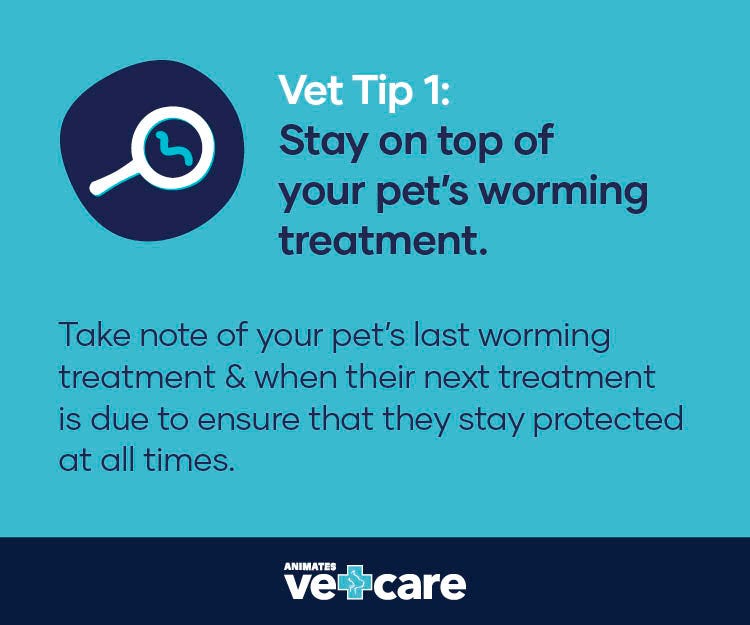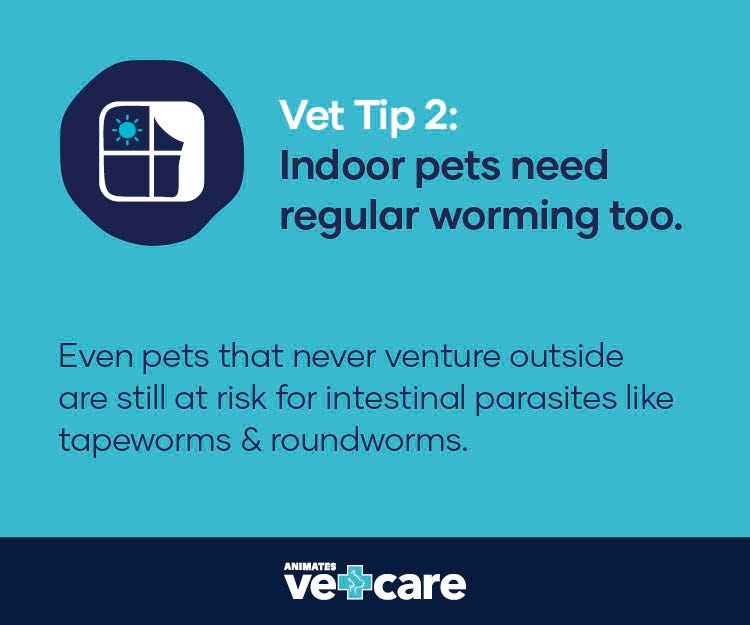How to tell if your pet has worms
One of the most common concerns that you may face as a dog or cat owner is whether or not your pet has worms. As gross as that thought may be, intestinal worms are easy to prevent.
Here’s the signs to look out for if you think your pet has worms.
Worms are a common problem for cats and dogs, especially young kittens and puppies. The nasty parasites live inside their stomach and intestines – getting first dibs on the nutrients and goodness in their food. The most common type of worms our pets get are roundworms, hookworms, whipworms and tapeworms.
Roundworms
Roundworms are an intestinal worm in cats and dogs that is often passed to young puppies and kittens through their mother’s milk or if they come into contact with contaminated faeces. Puppies can also be infected in-utero before birth. Infected puppies and kittens will often have a pot-bellied appearance, experience diarrhoea, and face issues with their growth.
Roundworms can be passed to humans and has been linked to many health issues. Cases of contracting roundworm are most common in young children, and if left untreated can sometimes result in serious consequences such as blindness.

Tapeworms
Tapeworms can be transmitted to our pets via fleas. The tapeworm starts developing inside fleas that have eaten tapeworm eggs, which the pet then swallows when grooming. Inside your pet the tapeworm develops into an adult and can grow up to half a metre long and deprive your pet of valuable nutrients. A pet will only show symptoms when there are many of them, such as diarrhoea or anal itchiness. Occasionally the segments (packets full of eggs) released by tapeworms cause anal irritation and your pet may show ‘scooting’.
Note: Contracting tapeworm from your pet is not common but can occur and is more likely in children. Ingesting an infected flea will give you this nasty intestinal worm that causes nausea, diarrhoea and loss of appetite in humans.
Hookworm
Found in the in the intestines of an infected animal, hookworms have a mouth-like part including teeth, which they use to attach themselves to the host’s intestine wall. Here, they feed and live off the blood of the host. They can be transmitted to your dog or cat in-utero, from their mother’s milk, or from the environment via contaminated faeces, water or soil.
Puppies and kittens are most vulnerable to the effects of hookworm which include anaemia from blood loss, causing them to be tired, weak and lose weight.

Whipworms
These worms are a parasite that infects dogs only, and not cats. Whipworms live in the large intestine and feed on the lining of the intestines and can be potentially fatal. Whipworms also suck blood which can lead to anaemia. It is often hard to diagnose whipworms in dogs and some may not even show symptoms of an infection until it becomes severe. Whipworm symptoms you should be wary of are diarrhoea and weight loss. Whipworms are more common in adult dogs than puppies, so regular worming protection at all ages is important.

Many pet owners think their pet is worm-free because they can’t see wriggling white bits, but worms are resourceful little pests – they try hard to stay hidden inside their host as long as possible to feed and survive. This means that, although your pet may appear perfectly healthy, they can still have a worm infection.
The effects of worms on your pet’s health can be extreme if left untreated. Intestinal worms vary in their degree of health risk, though hookworm can sometimes be fatal. Here’s some of the signs and symptoms of intestinal worms in cats & dogs:
- ‘Scooting’ (dragging their bottom across the ground)
- Weight loss
- Diarrhoea, especially with mucus or blood
- Visible worms in the stool or vomit
- Vomiting
- Weakness, lethargy or paleness, especially in puppies and kittens
- Dehydration
- Pot-bellied appearance, especially in puppies and kittens
It is important to remember that, usually the worms will remain hidden in your pet’s gut and will not be visible in your pet’s poo unless the infestation is advanced. If you suspect your pet has worms, you should seek professional advice from your local Animates Vetcare clinic.
A yucky fact: Some types of adult female worms can produce 200,000 eggs per day and some worms can grow to a staggering length of 100 cm inside your pet!

Our pets can get worms from a few different sources. The most common is from contact with the faeces of an infected animal; whether it be another pet in your household or the neighbour’s cat or dog.
Worms are common and easy to pick up – on the plus side, they’re easy to avoid if you regularly worm your furry friend, as they may have them without you even knowing! To find out how to protect your pet from intestinal worms, click below.








